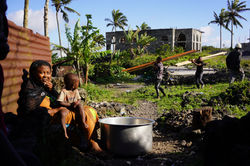MARION JOLY
 |
|---|
 |
 |
 |
 |
 |
 |
 |
 |
 |
 |
 |
 |
|---|
 |
 IMG_5555 |
 |
 |
 |
 |
 |
 |
 |
 |
 |
Changing weather and climate conditions worldwide – in combination with livelihood and food production systems, political trends, and human welfare – have affect patterns of human mobility and human population distribution. Research since the 1980s has inquired about the relationship between Earth´s changing environments and the movements of people – from voluntary and forced migration, displacement, on to relocation. As early as 1990, the Intergovernmental Panel on Climate Change (IPCC) warned that significant levels of human mobility could occur as a result of changing climatic conditions. Regions particularly sensitive to climatic stressors – whose societies often are very vulnerable to these and other stressors – include areas like low-lying islands and deltas, coastal zones, glacial-fed water systems and regions subject to persistent drought.
We live in an increasingly diverse world, even within our own family structures. The concept of the “nuclear” family does not predominate in our society as it once did.Despite the perfect picture families that always seem to loom over us on television, posters and bill boards, there are many more complexities and dynamics to families than all smiles and laughter. All families are different, and all families have their own issues.